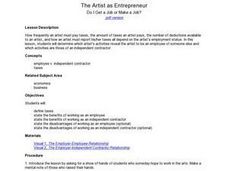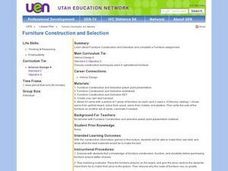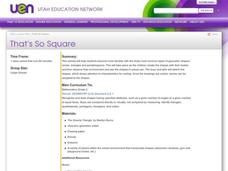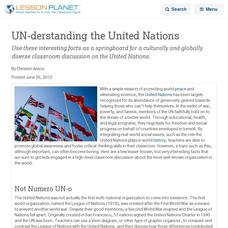Curated OER
Alternative Energy
Students identify the five major alternative energy sources. In this physical science instructional activity, students assess the advantages and disadvantages for each type of energy. They complete a concept map using information they...
Curated OER
Unit on Globalization and Foreign Investment
Twelfth graders examine the role of investment in an economy. They compare and contrast the different types of foreign investments. They also examine the differences between foreign direct investments and foreign portfolio investments.
Curated OER
The Bill of Rights Today
Students examine the Bill of Rights, They read the Bill of Rights and clarify the meaning of the material using different reading strategies. In groups, students brainstorm to compare and evaluate their conclusions with those of others.
Curated OER
Pie Crust Experiment
This experiment can be used as a pre-assessment to see what experience and knowledge the high schoolers have in preparing pies. They identify the difference in taste, flavor, texture and appearance as they substitute different...
Curated OER
Permutations
In this permutations instructional activity, 6th graders solve and complete 5 different types of problems. First, they write a simple conceptual art plan with no more than 3 instructions. Then, students use graph paper and a pencil to...
Curated OER
Driving Forces Forestry In Canada
Students discuss the natural and economic impact of forests and forestry. Using given statistics they construct different types of graphs in which they make observations and draw conclusions.
Curated OER
For All Time
Young scholars explore the oldest building in their community, then if any have gargoyles. They explore the date of the buildings and what types of materials were used to build the building.
Curated OER
Volcanoes
Fifth graders study volcanoes. They watch a demonstration that represents the eruption of a volcano and discuss the similarities and differences between the model and a real volcano.
Curated OER
External Influences 1
Students discover the main objectives of the government. They apply economic data to different scenerios. They present their findings to the class.
Curated OER
The Reservations
Third graders investigate the concept of a reservation and how it effects the lives of Native American indian tribes. They conduct research with the help of guiding questions to find the correct type of information. Students take notes...
Curated OER
Auditing the Energy-Guzzlers in Your Home
Students identify the energy sources in their community as renewable or non-renewable resources. Using their homes, they identify the types of energy they use to heat and power it. They calculate the amount of electricity used by each...
Curated OER
International Summit on Asia
Learners consider different aspects of Asia to determine which Asian country they think would be the best location for the American business development. They engage in a series of lessons designed to examine regions of Asia,...
Curated OER
The Artist as Entrepreneur: Do I Get a Job or Make a Job?
High schoolers discover the differences in being an entrepreneurial artist and an employed artist. They explore the tax codes, copyright laws and fringe benefits of being an employee versus an independent contractor.
Curated OER
Color Selection for a Quilt
Middle schoolers discuss the importance of using the proper color combinations in a quilt. In groups, they use the color wheel to design their section of the quilt for the class. To end the lesson, they are introduced to the various...
Curated OER
Coping with Crying/Shaken Baby Syndrome
Students listen as an expert on Shaken Baby syndrome speaks to their class and asks appropriate questions. Using a computerized doll, they discover the meanings behind baby's different crys and demonstrates what happens when a baby has...
Curated OER
Furniture Construction and Selection
High schoolers examine the different type of construction for a variety of furniture pieces. After watching a PowerPoint presentation, they discuss how to select the appropriate furniture for various floor plans. To end the lesson,...
Curated OER
That's So Square
Second graders are introduced to circles, triangles and parallelograms. As a class, they create the shape with their bodies and are shown the shapes in their actual size. To end the instructional activity, they sketch each shape and...
Curated OER
Engineering in a Calculus Classroom
Young scholars solve several differential equations. In this calculus lesson, students test their modulus calculation by testing different weights or beam lengths. They share their findings in class.
Curated OER
UN-derstanding the United Nations
Use these interesting facts as a springboard for a culturally and globally diverse classroom discussion on the United Nations.
Curated OER
Social Studies: Exploring Japan
Fourth graders examine the culture and environment of Japan, beginning with a KWL chart. They use clay and cups of water to construct representations of the Japanese Islands. After designing flags representing farming and food, 4th...
University of the Desert
What Is Extremism?
By participating in discussions using prompts and statements provided in the lesson plan, learners identify the concept of extremism and consider what causes violent acts of extremism in the modern world.
Curated OER
Dual place names in Australia
Students discuss landmarks commonly found on maps. They are divided into two groups, and asked to draw a map for a friend who hasn't been to the area. Group A may use street and place names, group B may not. Students discuss the role of...
Roy Rosenzweig Center for History and New Media
Immigrant Discrimination
For a class learning about Chinese and Irish immigration in America, here's a great starting lesson plan. It has your critical thinkers examining song lyrics, the Chinese Exclusion Act of 1882, and a political cartoon, and finally...
Curated OER
Analyzing Primary Sources
Analyzing primary and secondary sources is a necessary skill for students to attain, and can be learned through interesting activities.

























